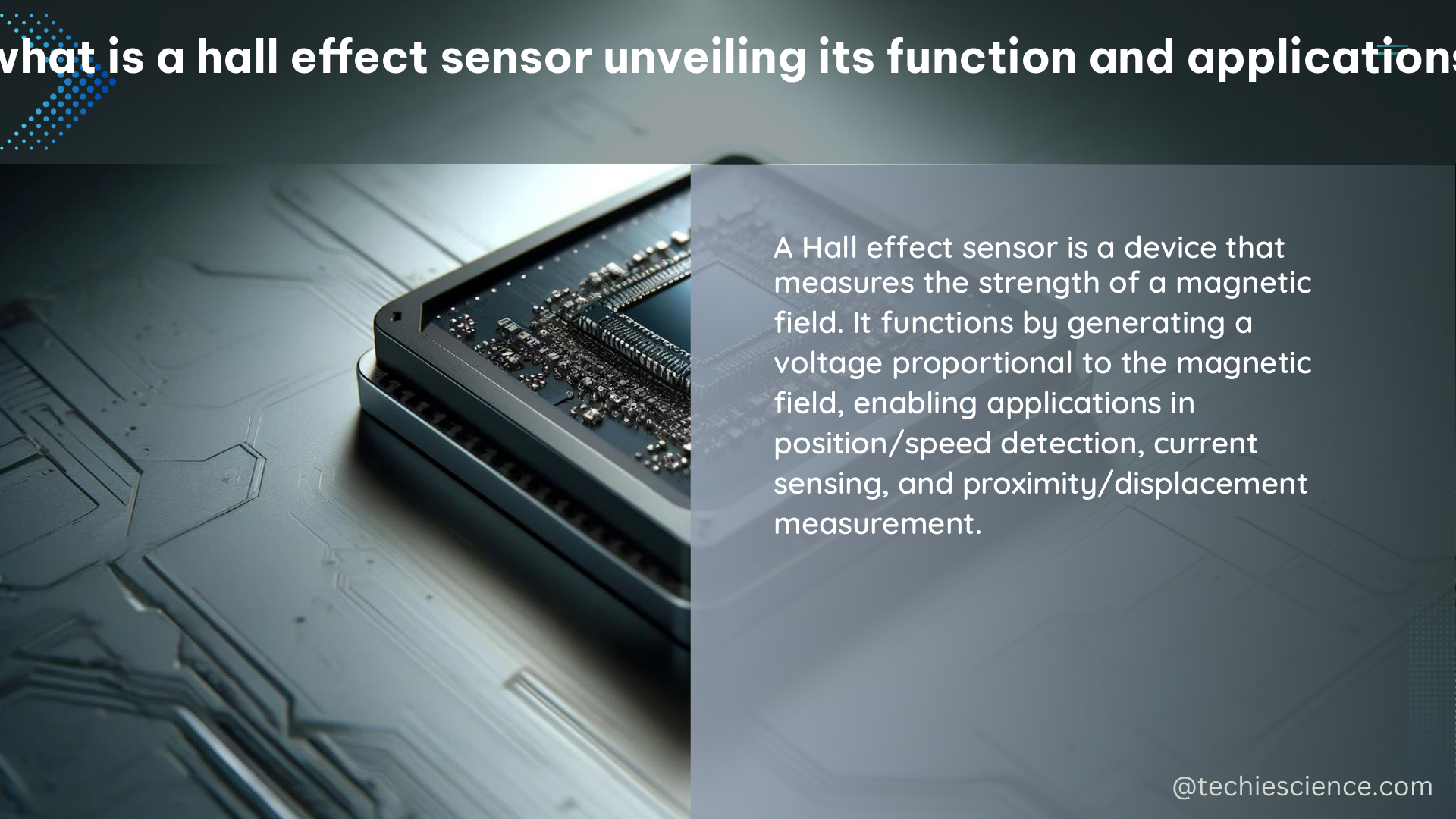A Hall effect sensor is a type of magnetic sensor that detects the strength and direction of a magnetic field produced from a permanent magnet or a ferromagnetic material. It works on the principle of the Hall effect, discovered by Edwin Hall in 1879, which states that when a magnetic field is applied perpendicular to the direction of the flow of electric current in a conductor, a voltage is generated perpendicular to both the magnetic field and the electric current. Hall effect sensors are used in various applications, including proximity sensing, positioning, speed detection, and current sensing, with hundreds of millions of Hall sensor ICs sold each year by around 50 manufacturers, generating a billion-dollar market.
Understanding the Hall Effect
The Hall effect occurs when a current-carrying conductor is placed in a magnetic field. The magnetic field exerts a force on the moving charge carriers, which causes them to accumulate on one side of the conductor. This separation of charge creates a voltage difference, known as the Hall voltage, which is perpendicular to both the direction of the current and the magnetic field.
The Hall voltage (VH) generated is proportional to the strength of the magnetic field (B), the current (I), and the thickness (t) of the conductor, and is inversely proportional to the number of charge carriers (n) and their charge (e). This relationship can be expressed as:
VH = (I × B) / (n × e × t)
The Hall effect is observed in various materials, including metals, semiconductors, and graphene. The choice of material for a Hall effect sensor depends on factors such as sensitivity, linearity, and temperature stability.
Key Components and Specifications of Hall Effect Sensors

Hall effect sensors typically consist of the following key components:
-
Hall element: This is the core of the sensor, where the Hall effect takes place. It is made of a thin, flat piece of semiconductor material, such as gallium arsenide (GaAs), indium arsenide (InAs), indium phosphide (InP), or indium antimonide (InSb).
-
Sensing electrodes: These are placed on opposite sides of the Hall element to measure the Hall voltage.
-
Bias current source: This provides a constant current flow through the Hall element.
-
Amplifier: Hall effect sensors produce a very low signal level, so they require amplification. Modern Hall sensor ICs integrate the sensor and a high-gain amplifier in a single package.
-
Voltage regulator: Some Hall sensor ICs also include a stable voltage regulator to allow operation over a wide range of supply voltages.
The key technical specifications of a Hall effect sensor include:
- Sensing axis: The component of the magnetic field vector that the sensor is designed to measure.
- DC bias current: The constant current flowing through the Hall element.
- Output signal: This can be an analog voltage, a pulse-width modulation (PWM) signal, or a digital communication protocol.
- Sensitivity: The ratio of the output signal to the incident magnetic field strength, often expressed in millivolts per gauss (mV/G).
- Quiescent output voltage: Typically half the supply voltage when no magnetic field is applied.
- Linearity: The degree to which the output is proportional to the input magnetic field.
- Ratiometric output: When the sensor’s sensitivity is proportional to the supply voltage.
- Directionality: The ability to measure only the sensing axis component of the magnetic field vector.
- Temperature stability: The sensor’s performance over a range of operating temperatures.
Applications of Hall Effect Sensors
Hall effect sensors have a wide range of applications in various industries, including:
-
Automotive: Throttle position sensing, crankshaft/camshaft position sensing, brushless DC motor control, and current sensing for power management.
-
Industrial automation: Proximity sensing, position and speed detection, current sensing, and flow metering.
-
Consumer electronics: Smartphone screen rotation, keyboard/mouse detection, and lid/door closure detection.
-
Robotics and drones: Magnetic field sensing for navigation, position, and orientation control.
-
Aerospace and defense: Magnetic field sensing for navigation, guidance, and control systems.
-
Medical equipment: Magnetic field sensing for prosthetic limb control, drug delivery systems, and patient monitoring devices.
-
White goods: Lid/door closure detection, motor control, and current sensing in appliances.
-
Energy and utilities: Current sensing for power distribution and monitoring, and magnetic field sensing for pipeline inspection.
Hall effect sensors offer several advantages over other sensing technologies, such as contactless operation, immunity to environmental contaminants, and lower cost. However, they also have limitations, such as sensitivity to stray magnetic fields, which can be addressed through the use of differential sensing or magnetic shielding.
Conclusion
Hall effect sensors are versatile and widely used in a variety of applications, from automotive and industrial automation to consumer electronics and medical equipment. Their ability to detect and measure magnetic fields, combined with their contactless operation and reliability, make them an essential component in many modern electronic systems. As technology continues to evolve, the applications of Hall effect sensors are likely to expand, driving further innovation and advancements in this field.
References:
- Allegro MicroSystems, Hall Effect Sensor | Applications Guide, https://www.allegromicro.com/en/insights-and-innovations/technical-documents/hall-effect-sensor-ic-publications/hall-effect-ic-applications-guide
- Wikipedia, Hall effect sensor, https://en.wikipedia.org/wiki/Hall_effect_sensor
- Arrow Electronics, Hall Effect Sensor Applications, https://www.arrow.com/en/research-and-events/articles/hall-effect-sensor-applications

The lambdageeks.com Core SME Team is a group of experienced subject matter experts from diverse scientific and technical fields including Physics, Chemistry, Technology,Electronics & Electrical Engineering, Automotive, Mechanical Engineering. Our team collaborates to create high-quality, well-researched articles on a wide range of science and technology topics for the lambdageeks.com website.
All Our Senior SME are having more than 7 Years of experience in the respective fields . They are either Working Industry Professionals or assocaited With different Universities. Refer Our Authors Page to get to know About our Core SMEs.